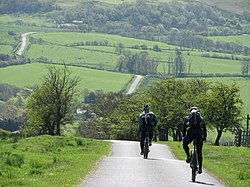Bewcastle: Difference between revisions
Created page with "{{Infobox town |name=Bewcastle |county=Cumberland |picture=Afdaling naar bewcastle.jpg |picture caption=Countryside near Bewcastle |population=411 |census year=2001 |os grid r..." |
|||
| Line 38: | Line 38: | ||
File:Bewcastle church and cross from the west.jpg|Bewcastle church and cross from the west | File:Bewcastle church and cross from the west.jpg|Bewcastle church and cross from the west | ||
File:Bewcastle cross south perspective view.jpg|Bewcastle cross south perspective view | File:Bewcastle cross south perspective view.jpg|Bewcastle cross south perspective view | ||
File:Bewcastle church interior.jpg|Interior of St Cuthbert's church | File:Bewcastle church interior.jpg|Interior of St Cuthbert's church | ||
File:Sundialtide.JPG|Example sundial at another location showing the four 'Tides' as on the Bewcastle Cross | File:Sundialtide.JPG|Example sundial at another location showing the four 'Tides' as on the Bewcastle Cross | ||
</gallery> | </gallery> | ||
Latest revision as of 08:40, 25 August 2015
| Bewcastle | |
| Cumberland | |
|---|---|
 Countryside near Bewcastle | |
| Location | |
| Grid reference: | NY565745 |
| Location: | 55°3’47"N, 2°40’57"W |
| Data | |
| Population: | 411 (2001) |
| Post town: | Carlisle / Newcastleton |
| Postcode: | CA6, TD9 |
| Dialling code: | 016977 |
| Local Government | |
| Council: | Cumberland |
| Parliamentary constituency: |
Penrith and The Border |
| Website: | bewcastle.com |
Bewcastle is a village in the north of Cumberland, in the hills north of Hadrian's Wall and on the Kirk Beck. It is a tiny place but the site of a famous Roman fort, north of the wall.
According to the 2001 census the parish had a population of 411. The parish is large but sparse, extending to the bounds of Dumfriesshire. It includes the hamlets of Roadhead, Shopford, Blackpool Gate, Roughsike and The Flatt. Within the parish are Bewcastle Castle and Askerton Castle.
Name
The origin of the name Bewcastle can be traced accurately from its spelling in ancient documents. These show that it was originally "bothy/booth caster", which suggests "Booth Fort". The original form of the first element "was clearly 'Buth-' from ON [Old Norse] búð, 'booth'."[1]. 'Cæster' is "an Anglian side-form of OE 'ceaster', referring to the defences of the Roman camp...a mediæval fortress was built within these defences..."[1]
Antiquarians, who did not have our access to well-catalogued and studied ancient documents, leapt at the chance to link the place name with a semi-mythological figure named Bueth, due to his romantic links with the prestigious Barony of Gilsland. The well-respected book "The Place-names of Cumberland" [2] states that it is impossible for Bewcastle to be named after Bueth.
Church and cross
St Cuthbert's churchyard contains the famous 7th Century Bewcastle Cross. The sundial on its surface is the oldest in Britain, divided into the four 'tides' which governed the working day in mediæval times. Its importance has been described by Nikolaus Pevsner thus; "The crosses of Bewcastle and Ruthwell....are the greatest achievement of their date in the whole of Europe."[3] A reconstruction of the whole cross is located in the churchyard of St Mary's neo-Romanesque Church at Wreay near Carlisle, but this differs in style and detail from the original. Stephen Matthews[4] calls the Wreay cross a "reinvention".
Roman Fort
Bewcastle is also known for its unusual hexagonal Roman fort, which has been identified as Fanum Cocidi. It was originally built from turf and timber and garrisoned by the First Nervian Cohort of Germans. It was later rebuilt in stone. Much of the stone was subsequently used to build a Norman castle, Bewcastle Castle.[5]
Pictures
-
Bewcastle castle
-
The castle
-
Bewcastle church and cross
-
Bewcastle church and cross from the west
-
Bewcastle cross south perspective view
-
Interior of St Cuthbert's church
-
Example sundial at another location showing the four 'Tides' as on the Bewcastle Cross
Outside links
| ("Wikimedia Commons" has material about Bewcastle) |
- Bewcastle website, description, history, Bewcastle Cross, what's on
- Brief description
- Information on Bewcastle from GENUKI
- Derivation of place-name
- FANVM COCIDI Roman Fort
References
- ↑ 1.0 1.1 Armstrong, A. M.; Mawer, A.; Stenton, F. M.; Dickens, B. (1950). The place-names of Cumberland. English Place-Name Society, vol.xx. Part 1. Cambridge: Cambridge University Press. pp. 60–61.
- ↑ Armstrong, 1950, p..60-61
- ↑ Pevsner, Nikolaus (1967) The buildings of England - Cumberland and Westmorland. Penguin Books.
- ↑ Matthews, S. 2007. Sarah Losh and Wreay Church; Bookcase, Carlisle
- ↑ 'Bewcastle' in The Cumberland News supplement 6 June 2014.
- Marshall, John (1978). A Biographical Dictionary of Railway Engineers. Newton Abbot: David & Charles. ISBN 0-7153-7489-3.







